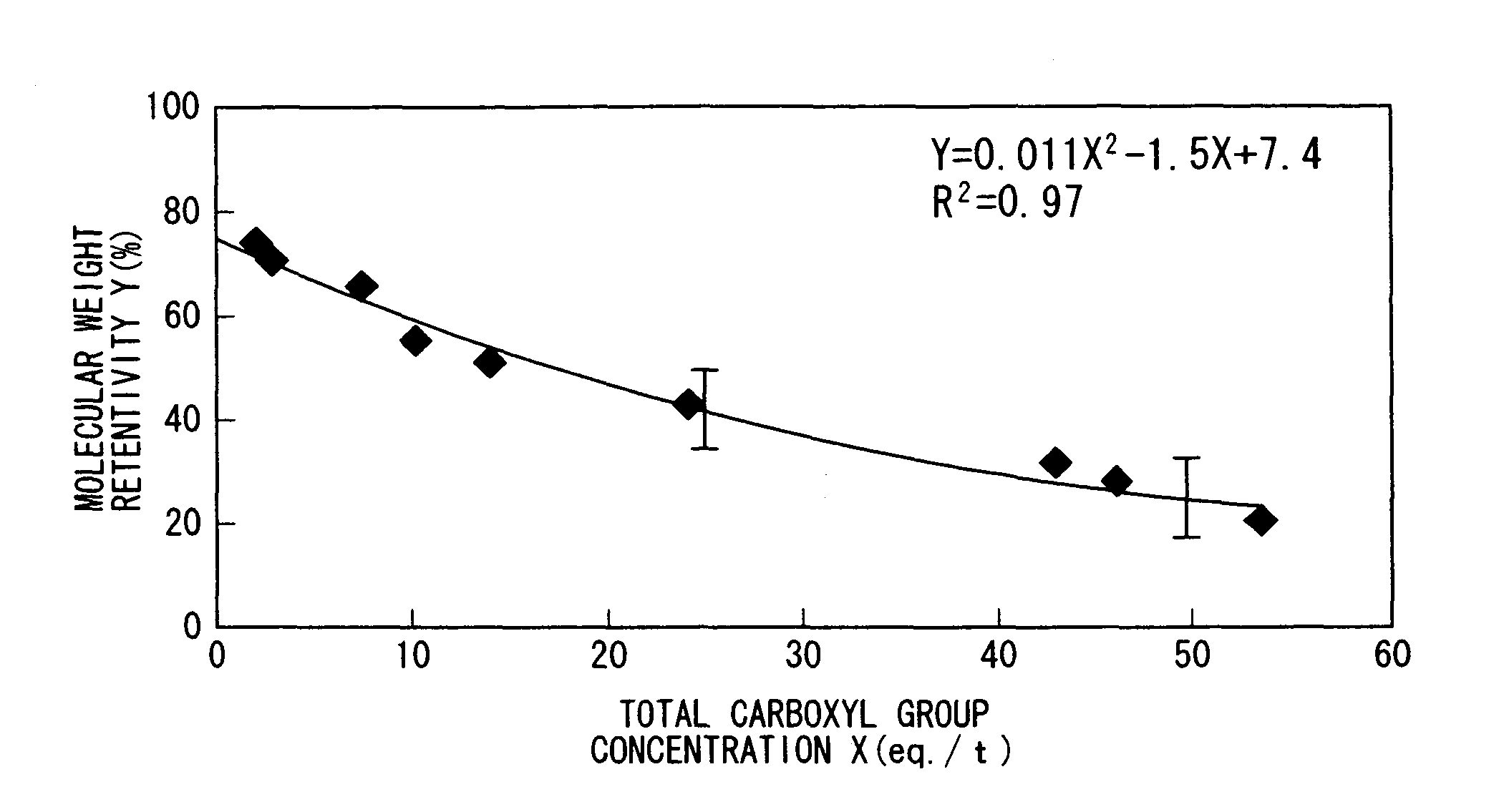Method for controlling water resistance of polyglycolic acid resin
a technology of polyglycolic acid and water resistance, which is applied in the direction of plastic/resin/waxes insulators, dyeing process, textiles and paper, etc., can solve the problem of not having a method of controlling moisture resistance, and achieve the effect of good accuracy and control of moisture resistan
- Summary
- Abstract
- Description
- Claims
- Application Information
AI Technical Summary
Benefits of technology
Problems solved by technology
Method used
Image
Examples
pga synthesis example 1
[0054]Into a SUS-made vessel equipped with a steam jacket structure and a stirrer, 450 kg of glycolide (made by Kureha Corporation, containing 360 ppm of glycolic acid dimer and 13 ppm of water) and 1600 g of n-dodecyl alcohol were added, then 13.5 g (30 ppm) of tin chloride dihydrate was added and, after closing the vessel, steam was circulated in the jacket under stirring of the contents to heat the contents up to 100° C. The contents became a uniform liquid in the course of the heating. While the temperature was held at 100° C., the contents were transferred to an apparatus comprising metal (SUS304)-made tubes each having an inner diameter of 28 mm and, immediately after completion of the transfer, an upper lid was affixed to the apparatus. A heating medium oil at 170° C. was circulated to the body of the apparatus for 7 hours, and lumps of polyglycolic acid (PGA) were obtained and pulverized by a pulverizer.
[0055]The thus-obtained PGA pulverizate was placed in a drier, to which ...
pga synthesis example 2
[0056]A PGA pulverizate was obtained in the same manner as in PGA Synthesis Example 1 except for adding 155 g of water instead of 1600 g of n-dodecyl alcohol.
PGA Extrusion Example 1
[0057]To a PGA pulverizate were respectively added a nearly equi-molar mixture of mono- and de-stearyl acid phosphate (trade name: “ADEKASTAB AX-71”, made by Asahi Denka Kogyo K. K.) (as a thermal stabilizer) at 300 ppm with respect to PGA and N,N-2,6-diisopropyl-phenylcarbodiimide (CDI, made by Kawaguchi Kagaku Kogyo K. K.). (as a carboxyl group-capping agent) at 0.5 wt. % with respect to PGA. The resultant mixture was extruded through a twin-screw extruder under the following conditions to obtain PGA pellets.
[0058](Extrusion Conditions)
[0059]Extruder: “LT-20”, made by K. K. Toyo Seiki Seisakusho Temperature set condition: The temperatures of zones C1-C4 from the feed port to the discharge port were sequentially set to 220° C., 230° C., 240° C. and 230° C.
PGA Extrusion Example 2
[0060]PGA pellets were obt...
example 1
[0068]The PGA pulverizate obtained in PGA Synthesis Example 1 was pelletized according to the method of PGA Extrusion Example 1 to obtain PGA pellets.
[0069]The PGA pellets were treated for 6 hours according to Heat treatment method 1 to recover PGA pellets.
[0070]Physical properties of the thus-obtained PGA pellets are shown in Table 1 together with the results of Examples 2-9 described below.
PUM
| Property | Measurement | Unit |
|---|---|---|
| temperature | aaaaa | aaaaa |
| temperature | aaaaa | aaaaa |
| heat-melting temperature | aaaaa | aaaaa |
Abstract
Description
Claims
Application Information
 Login to View More
Login to View More - R&D
- Intellectual Property
- Life Sciences
- Materials
- Tech Scout
- Unparalleled Data Quality
- Higher Quality Content
- 60% Fewer Hallucinations
Browse by: Latest US Patents, China's latest patents, Technical Efficacy Thesaurus, Application Domain, Technology Topic, Popular Technical Reports.
© 2025 PatSnap. All rights reserved.Legal|Privacy policy|Modern Slavery Act Transparency Statement|Sitemap|About US| Contact US: help@patsnap.com

